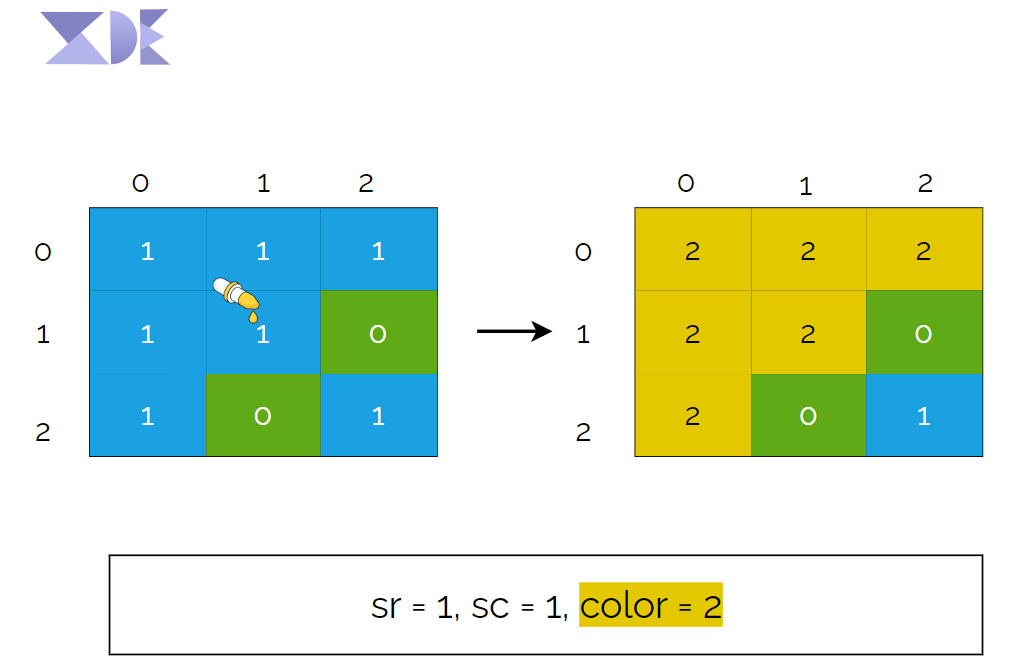Introduction to Flood Fill Algorithm
Level - Easy
Statement
An image is represented by an
m x ninteger grid image whereimage[i][j]represents the pixel value of the image.You are also given three integerssr, sc, and color. Perform a flood fill on the image starting from the pixelimage[sr][sc].
To perform a flood fill, consider the starting pixel, plus any pixels connected
4-directionallyto the starting pixel of the same color as the starting pixel, plus any pixels connected 4-directionally to those pixels (also with the same color), and so on.
Example
Input:
image = [[1,1,1],[1,1,0],[1,0,1]], sr = 1, sc = 1, color = 2
Output:
[[2,2,2],[2,2,0],[2,0,1]
You can try this at:
Algorithm Steps
- Start with the initial position (
sr,sc) in theimageand the desiredcolorto fill. - Retrieve the
old_colorat the starting position (sr,sc) from theimage. - If the
old_coloris already equal to the desiredcolor, no further action is required. Return theimageas it is. - Call the
dfsfunction to perform a depth-first search starting from the initial position (sr,sc). - In the
dfsfunction:- Check if the current position (
sr,sc) is out of bounds (less than 0 or greater than or equal to the size of theimage), and if so, return (base case). - Check if the color at the current position (
sr,sc) is equal to theold_color, and if not, return (base case). - Change the color at the current position (
sr,sc) to the desirednew_color. - Recursively call the
dfsfunction for the four adjacent positions by adding the corresponding values fromdxanddyarrays tosrandsc, respectively.
- Check if the current position (
- Once the
dfsfunction completes, return the modifiedimage. - The algorithm will fill the connected region in the
imagestarting from the initial position (sr,sc) with the desiredcolor. - Any other disconnected regions with the same color will remain unchanged.
Algorithm Dry Run(Visual Walkthrough)
Implementation
- Java
- CPP
- Python
class Solution {
int[] dx = {-1,1,0,0};
int[] dy = {0,0,-1,1};
public void dfs(int[][] image, int sr, int sc, int new_color,int old_color){
if(sr < 0 || sc < 0 || sr >= image.length || sc >= image[0].length)return;// base case
if(image[sr][sc]!=old_color)return;// base case don't change color if it is diff than old_color
image[sr][sc] = new_color;// change the color
// try all 4 directions
for(int i=0;i<4;i++){
int new_x = dx[i] + sr;
int new_y = dy[i] + sc;
dfs(image,new_x,new_y,new_color,old_color);
}
}
public int[][] floodFill(int[][] image, int sr, int sc, int color) {
int old_color = image[sr][sc];
if(old_color!=color)dfs(image,sr,sc,color,old_color);
return image;
}
}
class Solution {
private:
vector<int> dx = {-1, 1, 0, 0};
vector<int> dy = {0, 0, -1, 1};
void dfs(vector<vector<int>>& image, int sr, int sc, int new_color, int old_color) {
if (sr < 0 || sc < 0 || sr >= image.size() || sc >= image[0].size())
return; // base case
if (image[sr][sc] != old_color)
return; // base case, don't change color if it is different than old_color
image[sr][sc] = new_color; // change the color
// try all 4 directions
for (int i = 0; i < 4; i++) {
int new_x = dx[i] + sr;
int new_y = dy[i] + sc;
dfs(image, new_x, new_y, new_color, old_color);
}
}
public:
vector<vector<int>> floodFill(vector<vector<int>>& image, int sr, int sc, int color) {
int old_color = image[sr][sc];
if (old_color != color)
dfs(image, sr, sc, color, old_color);
return image;
}
};
class Solution:
dx = [-1, 1, 0, 0]
dy = [0, 0, -1, 1]
def dfs(self, image, sr, sc, new_color, old_color):
if sr < 0 or sc < 0 or sr >= len(image) or sc >= len(image[0]):
return # base case
if image[sr][sc] != old_color:
return # base case, don't change color if it is different than old_color
image[sr][sc] = new_color # change the color
# try all 4 directions
for i in range(4):
new_x = self.dx[i] + sr
new_y = self.dy[i] + sc
self.dfs(image, new_x, new_y, new_color, old_color)
def floodFill(self, image, sr, sc, color):
old_color = image[sr][sc]
if old_color != color:
self.dfs(image, sr, sc, color, old_color)
return image
Complexity
Time Complexity:
O(M*N)
Space Complexity:
O(M*N)
